Cover Crops

What are ‘cover crops’ and what are they for? Winter, 20241
Many years ago, a farming friend told me that villagers backing onto his field had been complaining of pesticides being sprayed onto wheat from the air and drifting into their gardens. In fact he was not spraying at all: he was sowing turnip seed as a cover crop to germinate immediately after combining!
In the past, I have not taken much notice of cover crops, but there is much discussion of them in the farming press. So in the autumn, I had a look at a couple of examples in our village.
Cover crops may be a mixture of plants sown into cereals before combining or into the stubble after combining. They can serve several purposes:
They cover and stabilise the topsoil from erosion and prevent it being washed into streams by winter rains.
As ‘green manure’ they mop up surplus nitrates in the soil after harvest and prevent them being leached into groundwater or running off into streams and ditches where they could increase algal blooms.
Their deep or fibrous roots help break up compacted soil.
Flowering cover crops provide a welcome late source of nectar to bees.
Sometimes they act as a nurse crop, smothering weeds and they aid in pest control.
In order to get a good seed-bed for the following crop of wheat or whatever, the cover crop needs to be removed: it can be grazed by sheep or cattle, mowed, treated with a herbicide or to some extent incorporated into the top-soil using a crimper roller. A crimper roller has knives designed to roll down and bruise cover crops in front of a direct drill. This ensures faster decomposition of the cover crop and allows the following crop to emerge through residues more quickly.
In September 2023, on the footpath between Lower Harlestone and Harlestone Firs, I noticed unfamiliar plants growing. I stopped to investigate and got out my smartphone with the ‘Picture This’ app – so useful! The plants about two feet tall were buckwheat. Looking closer, I could see very small oil-seed rape plants also growing in rows. The tops of the buckwheat plants were all twisted, a sign of hormone weed-killer.

A week later I bumped into the farmer and got the full story. The buckwheat and rape had been drilled at the same time, the buckwheat acting as a nurse crop to distract the dreaded cabbage stem flea beetle. In the UK, the beetle is the most important establishment pest of rape, leading to yield losses of up to 20%. Although buckwheat is short-lived and is killed by frost, there were thistles and other weeds in the field justifying the weed-killer spray. When I revisited the field later in November, the buckwheat and weeds were dead and the rape was thriving.
In Upper Harlestone, there is a large field of mostly white mustard. This is a fast-growing cover crop good at suppressing weeds and opening up the soil. Some claim it is a bio-fumigant (a plant which on rotting down into the soil releases substances toxic to organisms which might harm the crop). But it is also a good cover for game (pheasants and partridge). I gather, talking to Adey Greeno, the Conservation Manager for Althorp, that the estate home farm is now organic and a wide range of cover crops are being tried. So, on my next walk across the fields I shall be seeing which cover crops I can identify. While you too are out on a winter walk, keep an eye out for interesting cover crops and let me know what you find. Many farmers are working hard to protect their soils and our rivers.
1An earlier version of this article was printed in the Harlestone parish newsletter.

